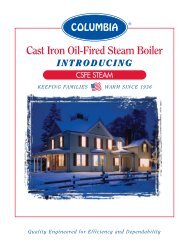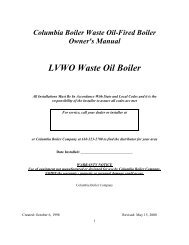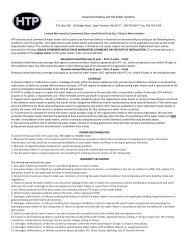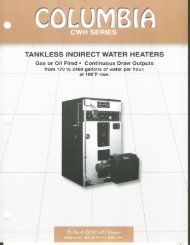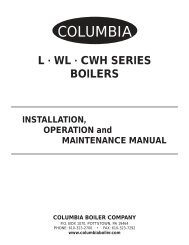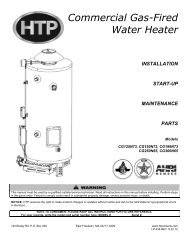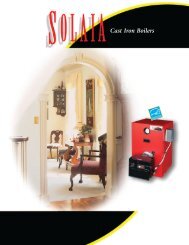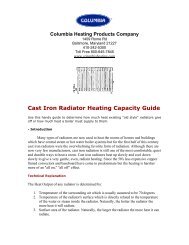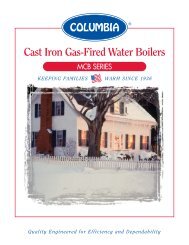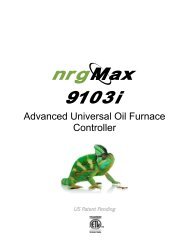CSVB Series II - Columbia Heating
CSVB Series II - Columbia Heating
CSVB Series II - Columbia Heating
- No tags were found...
Create successful ePaper yourself
Turn your PDF publications into a flip-book with our unique Google optimized e-Paper software.
HORIZONTAL VENTING INSTRUCTIONS9. Support Spacing:Do not restrict thermal expansion movement of thevent. The vent pipe must expand and contract freelywith temperature change. Each run of vent piping shallbe supported as follows:A. Z-Flex stainless steel vent piping requires a loosefitting metal strap or similar support at each jointat a maximum of 4 feet between supports.B. Heat-Fab stainless steel vent piping requires asupport for every 6 feet of horizontal piping run.The support must be secured using at least #10fasteners to a solid material (solid masonry orwood framing or blocking.) Do not fasten to drywallsheathing using hollow wall anchors. Each supportwill be 1½ inch lower than the previous supportwhen spaced 6 feet apart.C. Flex-L stainless steel vent piping requires a loosefitting metal strap or similar support at each jointat a maximum of 4 feet between supports.D. ProTech stainless steel vent piping requires oneloose fitting FasNSeal support strap for every 6’ ofhorizontal vent.10. If the horizontal vent must go through a crawl spaceor other unheated space, the cool temperatures willlikely cause the flue gases to continuously condenseinside the vent pipe. Do not insulate the vent pipe. Itmust be visible for monthly inspection. Insure that thevent pipe is properly pitched away from the boiler, withno low spots, so that condensate in the vent will drainaway from the boiler. An insulated enclosure or chase,with access for inspection and servicing of the vent,may be required to prevent freezing of liquid condensate.Consult the vent pipe manufacturer’s instructionsfor specific guidelines.11. At beginning of each heating season and monthlyduring the heating season, check all vent pipes andvent terminal to make sure there are no obstructions.Periodically clean the screen in the vent terminal.OPTIONAL HORIZONTAL VENTING INSTRUCTIONHorizontal venting with a power venter is an alternatemethod of sidewall venting. This boiler is CSA listed forsidewall venting with standard single wall galvanized orType B vent pipe when using the following power venterkits, which were specifically sized for these boilers:Table 3 - Field ControlsNumber OfField ControlsBoiler Sections Power Venter2, 3, 4, 5 SWG-4D6, 7 SWG-5DSome possible reasons for using a power venter forsidewall venting:1. May be preferred by local codes.2. Need a vent piping run beyond 30’ (9.1m) (but notmore than 50’ (15.2m)).3. The boiler installation site experiences gusting or highwinds. A power venter can help prevent the boiler fromshort cycling due to gusting or high winds by providingvent exhaust pressures greater than the boiler’sinduced draft blower alone.4. When installers or homeowners prefer a negativepressure vent system instead of a positive pressurevent system.5. May be more cost effective than stainless steelventing, particularly at longer vent length.The Field Controls power vent kit includes either aSWG-<strong>II</strong>-4HD or SWG-<strong>II</strong>-5 power venter, a MG-1 4”barometric draft controller, and the CK-43D controls kit.Confirm that installing a power venter is an option allowedby local codes. Follow the specific power venter installationinstructions issued with the power venter kits. Althoughthe power venter is equipped with its own fan, the fan onthe boiler remains in place and is unaltered when a powerventer is used.When sidewall venting, flue gases must be vented to apoint in relation to the prevailing wind so that they mayfreely disperse without being blown back at the buildingcausing discoloration, or into the building through doors orwindows causing odors. Also, under certain conditions fluegases will condense, forming moisture. In such cases, stepsshould be taken to prevent building materials at the ventterminal from being damaged by the exhausted flue gas.When installing single wall galvanized vent pipe for powerventing follow the specific power venter installationinstructions for layout, location of the barometric draftcontrol and termination connections.When joining and sealing the single wall galvanized or TypeB vent piping, use RTV silicone sealant with a minimumtemperature rating of 400°F. For 3” vent pipe runs, beginwith the female end of the vent pipe over the boiler’sinduced draft blower outlet. For 4” vent pipe runs beginwith the galvanized 3” to 4” increaser fitting (included inthe boiler’s parts bag) over the induced draft blower outlet.Then follow by placing the female end of the 4” vent pipeover the increaser fitting.When joining pieces of single wall galvanized vent pipe, asubstantial bead of silicone should be used at the joint toinsure a leak proof connection.18



